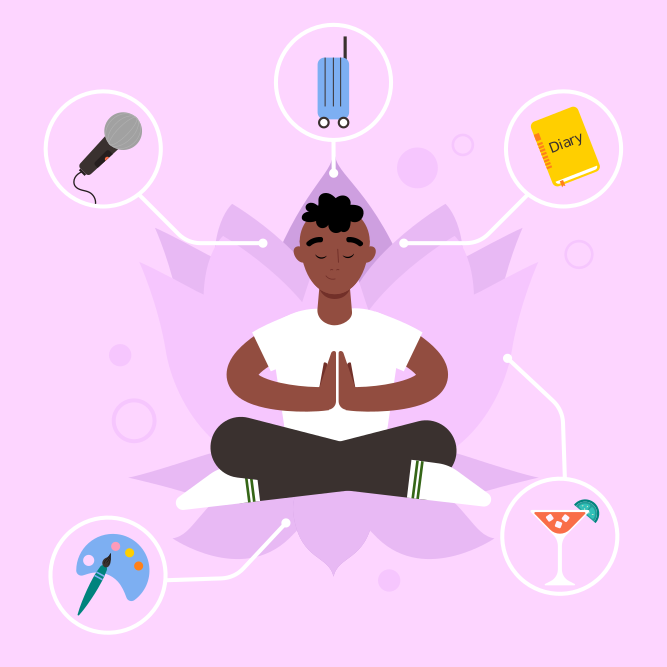
Table of Contents
Introduction
We all have habits—patterns or routines in the way we do things or the way we are. While good habits, like exercising regularly or eating healthily, can massively improve our lives, bad habits can result in a million damages. Breaking bad habits is a challenge so many people face, and it’s often overpowering, the journey to overcoming of such habits. One of the most efficient techniques to break vices involves being mindful.
Mindfulness besides giving insight into why we do what we do in our habits also gives us tools to get rid of them. This discussion is guided by ways through which mindfulness practices can help in breaking a bad habit, with emphasis on approaches to overcoming cravings and factors of behavioural therapy.
Bad Habits: Understand Them
Bad habits can be defined as behaviours that are knowingly repeated and bring negative consequences to our body, emotions, or mind. They generally start as a coping mechanism against stress, boredom, or any other negative emotion but soon turn into habits that are hard to stop.
Examples of bad habits include smoking, excessive drinking, overeating, nail-biting, procrastination, and too much time wasted on social media. While these habits give one short-term relief or satisfaction, they have longer-term negative consequences on health, productivity, and the quality of life.
Role of Cravings in Bad Habits
Cravings are very strong impulses to do something, which work to sustain bad habits. These strong urges are more often than not triggered through some situational or visual cue. For instance, someone who wants to stop smoking may get an extremely overwhelming desire to smoke when they see someone else smoke or become stressed or during certain times of the day.
Such is the intrinsic process involved in breaking bad habits: knowing and handling the cravings. Cravings are not just merely physical but also partly emotional and psychological, which makes them really complex to deal with.
How Mindfulness Practices Help
Mindfulness is being present and fully aware of one’s mental processes, feelings, and body sensations in the current moment, without judgment. It involves allowing insight into our usual patterns of behaviors and what triggers them. This is how mindfulness can help in breaking bad habits:

Awareness and Recognition:
Mindfulness practices heighten our ability to become aware of our habits and the occasions that set them off. By being more mindful of one’s thoughts and feelings, there is a clear opportunity to notice what patterns lead up to one’s bad habits.
Non-Judgmental Observation:
Mindfulness encourages one to observe cravings and behaviors with a non-judgmental attitude. This non-judgmental stance could help people understand their habits better and simultaneously not feel guilty or ashamed, which is counterproductive.
Reducing Stress:
Many bad habits are mechanisms to cope with stress. Mindfulness practices, through meditation and deep breathing, help reduce stress thereby enhancing the drive to combat bad habits.
Better Self-Regulation:
It strengthens our self-regulation and willpower. Through the constant practice of mindfulness, we can install a ‘pause button’ that allows choosing and acting conscious versus living life at cruising speed.
The Science Behind Mindfulness and Habit Change
It’s been proven that practicing mindfulness actually rewires the brain to increase self-control and decrease stress. This means that the prefrontal cortex, responsible for decision-making and impulse control, becomes more active, while the amygdala is responsible for stress and anxiety and becomes less responsive. This shift in activity within the brain can therefore help people better manage their cravings and make healthier choices.
A study published in the journal Psychological Science reported that those who participated in mindfulness meditation considerably improved their self-control and hence were better at fighting back impulses to consume tempting foods.
Another research article by the journal Substance Use & Misuse showed that mindfulness-based interventions worked with regards to reducing substance use and cravings in people suffering from substance use disorders.

Mindfulness Techniques for Breaking Bad Habits
Some mindfulness techniques are particularly effective at breaking a bad habit:
Mindful Breathing:
The technique is quite simple yet powerful. It just requires a person to focus on breathing. Any time when one gets the urge to do the habit, take a few deep breaths. Calming the mind and body reduces cravings.
Body Scan Meditation:
This is the mental process of going through your body from top to bottom, noticing any sensation or tightness. It helps to bring one’s awareness into how your body feels in the present moment, which can be particularly useful in times of craving.
Mindful Observation:
The next time that you have the urge to do something bad, take a minute and observe your environment. Look at the things around you, listen to the sounds, and smell the air. This might help you get your feet on the ground and not be so focused on your cravings.
Urge surfing:
This is a method by which you are surfing your cravings like you would a wave. You won’t fight the urge or try to quash it but instead acknowledge it and observe it with interest. Cravings oftentimes rise and fall in waves, and by “surfing” the urge, you will be able to learn that they are temporary and survivable.
Journaling:
By having a record of your thoughts and feelings, you will get to know the triggers and patterns of your bad habits. Whenever the urge strikes, jot down what you are craving, how you are feeling, and how you respond to the urge. This may turn out to be an excellent means of learning from those instances and building ways of overcoming them.
Add Behavioral Therapy
One of the more established methods of changing bad behaviors is behavioral therapy. When combined with mindfulness practices, it becomes very effective. Here’s how to use principles of behavioral therapy in conjunction with mindfulness:
Identify Triggers:
Behavioral therapy typically starts with understanding what triggers this bad habit. Mindfulness practice can enhance this process by increasing your awareness of what thoughts come, and what feelings arise when you encounter these triggers.
Alternative Response Development:
After identifying the triggers, behavioural therapy helps one develop alternative responses to these triggers. Mindfulness therefore will offer a pause between the trigger and one’s response to enable one to choose a healthier behaviour.
Reinforce Positive Behaviours:
Behavioural therapy stresses positive reinforcement of behaviours. Mindfulness can help in the following ways where it enables one to maintain focus on the goals and positive changes in one’s life.
Track Progress:
One of the intrinsic components of behavioral therapy is to keep track of your progress. Mindful journaling does this, which lets you document the whole journey and eventually celebrate your success.
Actionable Steps to Starting Your Mindfulness Journey
If you’re set to break your bad habits with mindfulness, here are some actionable steps to get you started:
Set Clear Intentions:
Define what bad habit one wants to break and set clear, achievable targets for the same. Put it down on paper and keep visiting it once in a while to remember why one started in the first place.
Create a Routine:
Develop a daily routine in mindfulness. Start with just a few minutes of mindful breathing or meditation every day and slowly increase the duration as one gets habituated to the practice.
Be Patient and Compassionate:
Breaking bad habits is a process that requires much time and effort. Be gentle and kind with yourself; cultivate self-compassion. Know that it is a process, and setbacks are a part of it. Use those as learning experiences.
Seek Support:
You may want to join a mindfulness group or even seek a therapist familiar with mindfulness training and behavioral therapy. Having a support system can give one the encouragement and accountability needed.
Practice Regularly:
The consistency developed is the key to mindfulness. Make mindfulness a regular part of your daily routine, whether through formal meditation or simply mindful breathing or keeping track of thoughts and feelings as they rise throughout the day.
Real-Life Examples of Mindfulness in Action
Giving up smoking:
John had been a smoker for more than a decade and had previously tried to give up several times, but with absolutely no success. Having attended an MBSR course, he started to nonjudgmentally observe his cravings. With the help of mindful breathing and surfing the urge, he slowly reduced his intake of cigarettes until he finally stopped smoking. He realized the importance of mindfulness in managing stress, therefore reducing his need to use smoking as a coping mechanism.

Conquering Emotional Eating:
Being an emotional eater, Sarah turned to food during periods of stress. With the implementation of mindfulness into everyday routine, she became more mindful of her emotional triggers and differentiated between hunger and emotional cravings. Mindful eating empowered Sarah to really savor her meals and make better food choices; these aided her tremendously in terms of weight loss and boosted her self-esteem.
Social Media Addiction Diminishes:
He slowly realized that excessive addiction to social media was hurting his productivity and mental health. Then he began to practice self-observation whenever he went to check his phone. By being more aware of his surroundings and deep breathing, he could bring down the screen time and rather focus on doing something meaningful in life. He also planned out when he would use social media, incorporating mindfulness into his routine.
Other Mindfulness Techniques You Should Try
Loving-Kindness Meditation:
This is a practice where you send kind and loving thoughts towards yourself and all other beings. It will calm your mind, leaving you with a positive outlook, and softening the negativity that can trigger bad habits.
Walking Meditation:
This is the act of paying close attention to physical sensations one gets while walking, like the movement of feet and rhythm of breath. Walking meditation offers an excellent way of bringing mindfulness into everyday routine and some physical exercise.
Mindful Stretching or Yoga:
Engaging your mind as you stretch or do yoga can help calm stress and provide further awareness of the body. Pay attention to your breath and the feelings in your body as you move through the poses.
Long-Term Advantages of Mindfulness
Mindfulness helps to break bad habits; it offers long-term benefits to health in general. These are:
Improved Mental Health:
Numerous pieces of research have been carried out on links between the regular practice of mindfulness and reduced symptoms of anxiety, depression, and stress, which in turn improves mental health and leads to emotional resilience.
Improved Concentration and Focus:
Mindfulness strengthens the brain’s ability to focus and concentrate; hence, it improves productivity and performance in different spheres of life.
Improved Concentration and Focus:
Improved Physical Health: It is associated with lower blood pressure, less chronic pain, and better sleeping quality.
Enhanced Self-Awareness:
By acts of mindfulness, people are capable of developing an awareness of thoughts, feelings, and behaviors, allowing for greater insight into themselves and thus leading to personal growth.
More Stable Relationships:
Through the practice of mindfulness, a person will have better relationships with others since the capacity for empathy, active listening, and effective communication is enhanced.
Conclusion
Breaking bad habits can be a really tough journey, but with mindfulness practices, there will be a really powerful tool to help in succeeding. One will become more conscious of habits and cravings that work to drive them, and he or she can develop healthier responses toward them. At last, one will break free from bad habits. Elements from behavioral therapy can be added to enhance the effectiveness of mindfulness practices in this regard.
It’s not a sprint to break bad habits, but a marathon. So, it calls for some patience while one is on their way to making conscious change. You can overcome your bad habits with time, practice, and perseverance to live a healthier and more rewarding life.


